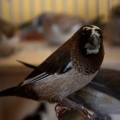
Cats
We love cats



Scientific Name:Lonchura domestica
Origin:China and Japan
A domesticated species developed originally by the Japanese as a fertile hybrid by using members of the genus Lonchura (members of the mannikin family) which they imported from China. This specie of bird is very easy to manage. The bird is keen to reproduce and is useful as a foster parent for Australian finches.
Description:Size 13 cm
Cock:Several different color forms exist including white, chocolate and white, chestnut and white, fawn and crested cocoa: Beak: Two-tone color. Body: white with chocolate, chestnut or fawn patterning. Markings vary greatly. Wings and tail usually have plenty of white feathers. Legs: dark or pale.
Hen:
Both birds are stocky with a heavy beak.
sex:The sex of Bengalese cannot be determined by physical appearance. The only way to determine their sexes is to be keeping a keen watch on the behavior of the bird. The cock bird puffs himself up to resemble a small balloon while singing.
Living conditions:Bengalese love to bathe and should be provided with suitable facilities. This specie may need to have its nails clipped.
Diet:
The Bengalese finch diet consists of a seed mixture for small birds. Millet is the principal seed in any finch formula. White millet, Red millet, Panicum millet, Plain canary seed, Niger, Linseed, Rape seed, Naked oats, and a good form of conditioning seed, including millet sprays, green stuff, and fruit. Many breeders like to mix their own, or if you prefer an already pre-mixed bag of Foreign Finch mixed seed can be obtained from different outlets either by the kilo or 15 to 20kg bags.
Bengalese Finch Breeding:
Bengalese commences breeding as early as eight months of age. Nest boxes should be provided with a rather small entrance hole, much preferred by this species. A rather untidy nest is made inside the box and the birds like to be well hidden while incubating.
Six to eight eggs are normally laid and both parents sit side by side in the nest during the incubation period of 14 days.
The young are carefully fed by both parents for about 21 days. When rearing their young, Bengalese should be provided with egg food, soaked bread, meal worms and some green food
During the time of breeding it would be ideal to keep them undisturbed. Though the bird allows frequent cage inspections but it should be left on its own while breeding.